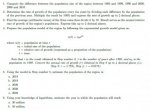Oh. I'm really sorry. I'm in Grade 11 studying Exponential Growth and Decay.
Here's how my work goes:
Given that the population in:
1980: 5,925,884
1990: 7,948,392
2000: 9,932,560
2010: 11,855,975
1. Compute the difference between the population size of the region between 1980 and 1990, 1990 and 2000,
2000 and 2010.
(I subtract)
Between 1990 and 1980: 2,022,508
Between 2000 and 1990: 1,984,168
Between 2010 and 2000: 1,923,415
THIS IS CORRECT
2. Determine the rate of growth of the population every ten years by dividing each difference by the population
of the previous year. Multiply the result by 100% and express the rate of growth up to 2 decimal places.
2,022,508/7,948,392= 0.25445 x 100 = 25.45%
1,984,168/9,932,560= 0.19976 x 100 = 19.98%
1,923,415/11,855,975= 0.16223 x 100 = 16.22%
THIS IS IN ERROR. Growth between 1980 and 1990 was 2,022,508, which was the actual growth from 1980, the EARLIER year. You should be dividing by the population for 1980.
3. Find the average (arithmetic mean) of the three rates then divide it by 10. Result serves as the annual relative
rate of growth of the region's population. Express this up to 2 decimal places.
0.2545 + 0.1998 + 0.1622 / 3 = 0.2055 or 20.55%/10 = 2.06%
4. Prepare the population model of the region by following the exponential growth model given as:
n(t) = n0ert
where n(t) = population at time t
n0 = initial size of the population
r = relative rate of growth (expressed as a proportion of the population)
t = time
Note that r is the result obtained in Step number 2, t is the number of years after 1980, and n0 is the
population in 1980. Convert the annual rate of growth (r) obtained in Step 2 up to 4 decimal places (i.e.
Step 2: r = 1:75%; Step 4: r = 0:0175)
Uhh I don't really get this/how should I model it
5. Using the model in Step number 5, estimate the population of the region in:
a. 2018
2018-1980=38, n(38)=5925884e0.0206(38)
12,963,398.34
b. 2019
2019-1980=39, n(39)=5925884e0.0206(39)
13,233,213.91
c. 2020
2020-1980=40, n(40)=5925884e0.0206(40)
13,508,645.32
d. 2030
2030-1980=50, n(50)=5925884e0.0206(50)
16,598,791.21
e. 2040
2040-1980=60, n(60)=5925884e0.0206(60)
20,395,817.89
6. Using your knowledge of logarithms, estimate the year in which the population will reach
a. 30 million
30000000=5925884e0.0206t, 5.062535817=e0.0206t, ln(5.062535817)=0.0206t*ln(e), ln(5.06253817)/0.0206=t,
t=78.73 (Exact Value: 78.7314324), 1980+78.73= 2058.73
b. 50 million
50000000=5925884e0.0206t, 8.437559696=e0.0206t, ln(8.437559696)=0.0206t*ln(e), ln(8.437559696)/0.0206=t,
t=103.53 (Exact Value: 103.5287928), 1980+103.53= 2083.53
Those are my answers. I'm not really sure if they're totally correct. If I input only 2 decimal places on the calculator to prove that the equal value is true, it won't give me the EXACT answer but near to very near the value (can be rounded off) so I guess that's okay? E.g., 30000000=5925884e0.0206(78.73) is only equals to 29,999,114.79. But if I put the exact value of T (78.7314324), the answer is exactly 30,000,000. In the annual relative growth, if I put the exact value vs the rounded off one, the value will not be as exact but still near. I tried to reverse solve it, using the formula that I've made and concluded, the population of 2010 is 11,855,975, so 2010-1980=30, 5925884e0.0206(30)=11855875, but 10,993,782 is not equal to 11,855,975. Did I do something, please help I'm really confused on what would be the basis of the values that I should use, should it be the exact whole value then round it off to 2 decimal places or round it off first as instructed by the problem?


